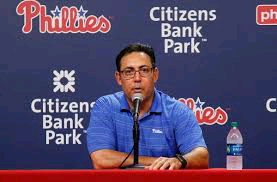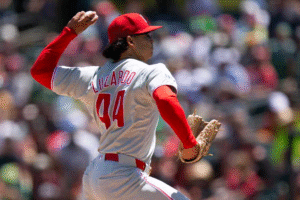
Philadelphia Phillies vs. Baltimore Orioles: 2025 Series Preview and In-Depth Analysis
As the MLB regular season barrels into August, the Philadelphia Phillies and Baltimore Orioles prepare to face off in a midseason interleague clash at Citizens Bank Park. Historically, matchups between these two franchises have seen competitive moments, especially when both teams were playoff-caliber opponents. However, in 2025, the tone of this series is markedly different. The Phillies come into the series holding a strong 63-48 record, firmly in the playoff hunt. In contrast, the Orioles limp into Philadelphia with a disappointing 51-61 record, buried 13.5 games back in the American League playoff race.

Once considered one of the more promising young squads in the league, Baltimore’s 2025 season has unfolded in unexpected and disappointing ways. Pundits and fans alike believed that the team’s blend of youthful talent and experience would fuel another run to October, especially following back-to-back postseason appearances. However, this year’s club has struggled to generate momentum, hindered by poor pitching and inconsistent performances across the board.
Baltimore’s Collapse in Context
Entering this season, expectations were high for Baltimore’s core—a group that included franchise cornerstone Adley Rutschman, former top overall pick Jackson Holliday, and breakout slugger Gunnar Henderson. The Orioles had turned heads in recent seasons with their farm system development and had built up a wave of optimism with playoff berths in 2023 and 2024. However, the cracks in the rotation and bullpen quickly revealed themselves, leading to one of the more dismal campaigns among American League clubs this season.
A glaring weakness has been the team’s pitching. Baltimore owns an abysmal team ERA of 4.83, significantly worse than the league average, and an ERA+ of 83, meaning they’re 17% worse than the average MLB pitching staff. With such ineffective arms, the team has rarely been in contention in many of their games, and even their offensive talent hasn’t been able to compensate.
As the 2025 trade deadline approached, Baltimore officially embraced the role of a seller. Several notable players were shipped off to contending teams, signaling a pivot back toward long-term rebuilding.
Seranthony Dominguez, a former Philadelphia Phillies reliever who had become a fan favorite in Philly during his early years, was dealt to the Toronto Blue Jays.
Cedric Mullins, a key member of the Orioles’ outfield and a major contributor during their playoff pushes, was traded to the New York Mets.
Ryan O’Hearn and Ramon Laureano, both veterans who provided some power and utility in the lineup, were sent to the San Diego Padres
Despite these moves, Baltimore has retained its most important young stars: Rutschman, Henderson, Holliday, and infielder Jordan Westburg. These players remain the foundation upon which the franchise hopes to rebuild and return to contention in future seasons. That said, the 2025 campaign now represents little more than a development year for Baltimore’s core.
Philadelphia’s Position Heading into the Series
The Phillies, meanwhile, are aiming to make another strong playoff run. They sit above .500 and are in the thick of the National League race. Their performance has been powered by a strong offense and mostly solid starting pitching, though the rotation has seen its share of inconsistencies.
Luckily for Baltimore, Philadelphia’s top two arms—Zack Wheeler and Cristopher Sanchez—won’t be pitching in this three-game set. That provides some temporary relief for a struggling Orioles offense. Nevertheless, the Phillies’ home-field advantage should be significant, particularly as they ride momentum from a successful recent homestand against the Detroit Tigers.
Let’s break down each game of the series with in-depth looks at the pitching matchups, player performance trends, and possible outcomes.
Game 1: Jesus Luzardo (PHI) vs. Cade Povich (BAL)
Luzardo (9-5, 4.31 ERA)
Povich (2-5, 5.15 ERA)
The series opener offers a duel between two southpaws with very different trajectories and upside.
Jesus Luzardo: Flashes of Greatness, Lingering Questions
Once a highly touted prospect and now a mid-rotation anchor for the Phillies, Jesus Luzardo has been a roller coaster ride this season. While his 4.31 ERA reflects an average year statistically, his individual game logs tell a more erratic story.
Dating back to mid-June, Luzardo has alternated between dazzling and dreadful outings. In three of his recent starts, he pitched deep into the seventh inning without allowing a single run, showcasing the electric stuff that once made him a top talent in Oakland. However, in the other five starts in that same time span, Luzardo was lit up, compiling an ERA of 8.72 and struggling to pitch beyond the fifth inning.
Much of this volatility has prompted analysts to speculate about mechanical or strategic flaws. Some have suggested he may be tipping pitches—perhaps showing signs in his delivery that give away what’s coming. Others have pointed to his struggles pitching from the stretch, where he seems to lose command and velocity.
Still, Luzardo showed signs of a potential turnaround in his last outing—seven shutout innings against the Chicago White Sox. If he can carry that momentum into Game 1, he could dominate a depleted Baltimore lineup.
Cade Povich: Rotation Depth or Liability?
For the Orioles, Cade Povich is still attempting to find his footing in the big leagues. Now in his second MLB season, Povich has been a serviceable but underwhelming back-end starter. His 5.15 ERA is only marginally better than last year’s 5.20, and while there are some encouraging signs under the hood, he hasn’t been able to turn them into results.
His Fielding Independent Pitching (FIP) of 4.13 suggests that he’s pitched slightly better than his ERA indicates, but his expected ERA (xERA) is a troubling 6.13, placing him among the worst in the league. In other words, advanced metrics suggest that unless something changes, his performance could worsen.
Povich mixes five pitches: a four-seam fastball, curveball, sweeper, changeup, and sinker. Unfortunately, he lacks premium velocity—topping out at around 93 mph—and doesn’t have a true out pitch. He’ll need pinpoint command and sequencing to navigate the Phillies’ dangerous lineup.
Game 2: Taijuan Walker (PHI) vs. Dean Kremer (BAL)
Walker (3-5, 3.82 ERA)
Kremer (8-7, 4.27 ERA)
The second game features two pitchers who have carved out important roles for their teams, even if they aren’t considered frontline starters.
Taijuan Walker: Steady if Unspectacular
Philadelphia signed Taijuan Walker to a four-year, $72 million contract ahead of the 2023 season, hoping for mid-rotation reliability. While fans have occasionally criticized his performance relative to that price tag, Walker has mostly delivered what was expected in 2025—he’s been solid, if unspectacular.
In 23 total appearances (including 12 starts), he has a 3.82 ERA, though he’s rarely pitched deep into games. In fact, he hasn’t recorded an out beyond the sixth inning since his season debut. Manager Rob Thomson has kept him on a relatively tight leash, often pulling him before his pitch count reaches 85.
Still, with injuries affecting the rotation earlier in the season, Walker has played a crucial role in stabilizing the back end. His ability to prevent blowups, even if he’s not racking up strikeouts or innings, is valuable for a contending team like the Phillies.
Dean Kremer: A Rare Bright Spot for Baltimore
The Orioles’ rotation has been a major weakness, but Dean Kremer has been one of the few bright spots. Since becoming a regular starter in 2022, Kremer has quietly developed into a reliable contributor. While he’s never been dominant, his ability to consistently pitch around a 4.20 ERA has made him valuable.
In 2025, Kremer continues to perform within that same range—his 4.27 ERA is entirely in line with his previous seasons. He doesn’t have overpowering stuff, but he locates well and mixes pitches effectively. On a deeper staff, Kremer would likely slot in as a No. 4 or No. 5 starter. But on this year’s Orioles squad, he’s been counted on as a key arm.
Given the lack of elite depth in the Baltimore bullpen, Kremer’s ability to go six or seven innings could prove important if the Orioles hope to steal a game in this series.
Game 3: Ranger Suarez (PHI) vs. Trevor Rogers (BAL)
Suarez (7-3, 2.15 ERA)
Rogers (4-2, 1.44 ERA)
The series finale promises to be a fascinating pitcher’s duel between two lefties enjoying strong 2025 campaigns—Ranger Suarez for the Phillies and Trevor Rogers for the Orioles.
Ranger Suarez: Bounce-Back Candidate Turned Ace?
Ranger Suarez has quietly become one of the most reliable pitchers in baseball over the past few seasons. His pinpoint control and deceptive delivery make up for average velocity, and he’s developed a knack for escaping trouble without damage.
After posting a phenomenal 1.30 ERA in June across nearly 42 innings, Suarez hit a bit of turbulence in July. Over his last five starts, his ERA has risen to 4.40, though his last two outings—solid performances against the Yankees and Tigers—suggest he may be turning things back around.
With the Phillies eyeing a deep playoff run, Suarez will be a crucial piece in the postseason rotation. His ability to generate soft contact and go deep into games gives the team options as they manage innings.
Trevor Rogers: The Best Under-the-Radar Story in Baseball?
For the Orioles, Trevor Rogers might be the silver lining of the 2025 season. After battling injuries and inconsistency earlier in his career, Rogers has come roaring back in 2025 with a stunning 1.44 ERA over 56.1 innings. However, there are indications that regression may be on the horizon.
His FIP (2.61) and xERA (3.28) are both excellent, but significantly higher than his actual ERA, suggesting he’s benefited from strong defense or fortunate batted-ball luck. Still, there’s no denying that he’s been among the best in the league over the last month.
Since July 6, Rogers has given up just four earned runs in over 34 innings. He’s coming off a season-best start—an eight-inning gem against the Chicago Cubs where he didn’t issue a single walk and fanned eight batters. His confidence is growing, and the Phillies will have their hands full trying to solve him.
Final Thoughts: A Series of Contrasts
This series sets up as a showcase of two teams moving in different directions. The Philadelphia Phillies are playoff hopefuls looking to maintain momentum, while the Baltimore Orioles are experimenting with lineups and building for 2026 and beyond. Philadelphia’s stronger rotation, deeper bullpen, and home-field advantage should give them the edge in the series. However, with Rogers and Kremer still in the mix, Baltimore could play spoiler.
Citizens Bank Park will be rocking, and every win matters for the Phillies in a tight National League race. Meanwhile, Baltimore will be watching closely to evaluate which young players can be part of the solution moving forward.
Whether it’s a showcase of talent like Adley Rutschman or a resurgence story like Trevor Rogers, this interleague matchup provides plenty of intriguing storylines for fans of both teams—and baseball at large.
Leave a Reply